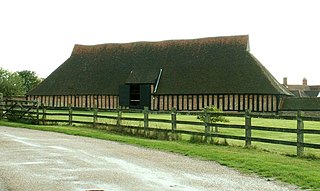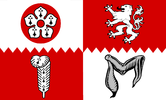A preceptor is a teacher responsible to uphold a certain law or tradition, a precept.

Temple Bruer Preceptory is in a farm-yard in the civil parish of Temple Bruer with Temple High Grange, North Kesteven, Lincolnshire, England. It is one of the few Knights Templar sites left in England where any ruins remain standing. Its name comes from its Templar ownership and its position in the middle of the Lincoln Heath, bruyère (heather) from the French language current at the time. It was founded in the period 1150 to 1160 and the order was dissolved in 1312. The site is at grid reference TF 0085 5370, located between the A15 and A607 roads, 2.5 miles (4.0 km) north from Cranwell. The site has been excavated twice, firstly by the Rev Dr. G. Oliver, the rector of Scopwick in 1832-3, and in 1908 by Sir William St John Hope.
Thomas Babington was an English philanthropist and politician. He was a member of the Clapham Sect, alongside more famous abolitionists such as William Wilberforce and Hannah More. An active anti-slavery campaigner, he had reservations about the participation of women associations in the movement.

Bottesford Preceptory was sited at Bottesford, just to the south of Scunthorpe, in Lindsey, England. It was on low-lying land, near the Bottesford Beck, about 3 miles (5 km) to the west of the escarpment of the Lincoln Cliff limestone upland, and about the same distance to the east of the River Trent. A preceptory was a community of the Knights Templar who lived on one of that order's estates in the charge of its preceptor. A preceptory also referred to the estate and its buildings. The present Bottesford Manor is believed to have been the gatehouse to the preceptory.

Aslackby Preceptory in Lincolnshire lay to the south-east of Aslackby Church. Until about 1891 a tower, possibly of the preceptory church, together with a vaulted undercroft, survived as part the Temple farmhouse. Temple farmhouse was subsequently rebuilt and a 15th-century window and a stone pinnacle remain in the garden

Newland with Woodhouse Moor is a civil parish in the City of Wakefield in West Yorkshire, England, consisting of some open countryside west of Normanton, including Newland Hall.

Temple Normanton is a village and a civil parish in Derbyshire, England. The population of the civil parish at the 2011 census was 490. It is in the North East Derbyshire district of the county.

Gaddesby is a village and civil parish in the Melton borough of Leicestershire, England. The population of the civil parish at the 2011 census was 762. It is located around 5.5 miles (8.9 km) southwest of Melton Mowbray and 8 miles (13 km) northeast of Leicester.

Cressing Temple is an ancient monument situated between Witham and Braintree in Essex, close to the villages of Cressing and White Notley. It was amongst the very earliest and largest of the possessions of the Knights Templar in England, and is currently open to the public as a visitor site. It is the location of three Grade I listed Medieval barns, one of which is the oldest standing timber-framed barn in the world.
Baddesley Preceptory was a preceptory of the Knights Hospitaller at North Baddesley in Hampshire, England. The preceptory was founded at Godsfield but was moved soon after the Black Death.

Yeaveley Preceptory, also known as Stydd Preceptory, was a preceptory of the Knights Hospitaller, near to the village of Yeaveley, in Derbyshire, England. It was located around a mile west of the village, on the site of the current Stydd Hall. The Preceptory has been variously known as "Yeaveley Preceptory", "Yeaveley Bailiwick", "Yeaveley and Barrow Preceptory" and "Stydd Preceptory".
Temple Hirst Preceptory was a priory in North Yorkshire, England.
The history of the Knights Templar in England began when the French nobleman Hughes de Payens, the founder and Grand Master of the order of the Knights Templar, visited the country in 1128 to raise men and money for the Crusades.

Heather Preceptory was a preceptory of the Knights Hospitaller, established in the village of Heather, Leicestershire, United Kingdom.

Dalby Preceptory, also known as Dalby and Heather Preceptory, was a preceptory of the Knights Hospitaller, in the village of Old Dalby, Leicestershire, England.

Swinford Preceptory is a former monastery of the Knights Hospitaller located near to the village of Swinford, Leicestershire.

The site of the former preceptory at Temple Hill, South Witham. It 'has been largely under pasture' since the Knights Templar left in 1308.]] Withham Preceptory, one of the smallest Knights Templar preceptories in England, was founded, before 1164, at Temple Hill, near South Witham, Lincolnshire, and was abandoned in the early 14th century.




























